FolkWorld Issue 36 07/2008;
Article from Wikipedia, the free encyclopedia
Chinese Music
From Wikipedia, the free encyclopedia

Tuning in to the Olympic Summer Games in Beijing 2008:
The Music of China dates back to the dawn of Chinese civilization with documents and artifacts providing evidence of a well-developed musical culture as early as the Zhou Dynasty (1122 - 256 BC). Today, Chinese Music continues a rich traditional heritage in one aspect, while emerging into a more contemporary form at the same time.
The music of China dates back to the dawn of Chinese civilization with documents and artifacts providing evidence of a well-developed musical culture as early as the Zhou Dynasty (1122 BC - 256 BC).
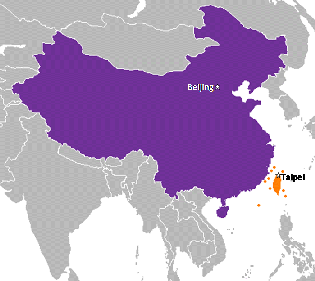
 The People's Republic of China (simplified Chinese: 中华人民共和国; traditional Chinese: 中華人民共和國; pinyin: Zhōnghuá Rénmín Gònghéguó listen (help·info)), commonly known as China, is the largest country in East Asia and the third or fourth largest country in the world.
With a population of over 1.3 billion it is the most populous country in the world. Beijing is the capital.
The People's Republic of China (simplified Chinese: 中华人民共和国; traditional Chinese: 中華人民共和國; pinyin: Zhōnghuá Rénmín Gònghéguó listen (help·info)), commonly known as China, is the largest country in East Asia and the third or fourth largest country in the world.
With a population of over 1.3 billion it is the most populous country in the world. Beijing is the capital.
The 2008 Summer Olympics will be celebrated from August 8, 2008, to August 24, 2008.
The Olympic slogan, One World, One Dream, calls upon the world to unite in the Olympic spirit.
Concerns over the games include the potential for boycotts from pro-Tibetan organizations such as Students for a Free Tibet as well as from organizations such as Amnesty International upset with China's involvement in the crisis in Darfur.
People's Republic of China,
China,
2008 Summer Olympics
Human Rights in the People's Republic of China
|
Today, the music continues a rich traditional heritage in one aspect, while emerging into a more contemporary form at the same time. In summary the commercialized segment is in Hong Kong and Taiwan. The more diverse and sophisticated genres and aspects are in mainland China.
History
The legendary founder of music in Chinese mythology was Ling Lun, who made bamboo pipes tuned to the sounds of birds.
Dynasty era (1122 BC - 1911)
According to Mencius, a powerful ruler had asked him whether it was moral if he preferred popular music to the classics. The answer was that the only thing matters being whether or not he loved his subjects. The Imperial Music Bureau, first established in the Qin Dynasty (221-207 BC), was greatly expanded under the Emperor Han Wu Di (140-87 BC) and charged with supervising court music and military music and determining what folk music would be officially recognized. In subsequent dynasties, the development of Chinese music was strongly influenced by foreign music, especially that of Central Asia.
The oldest written music is Youlan or the Solitary Orchid, attributed to Confucius (see guqin article for a sample of tablature). The first major well-documented flowering of Chinese music was for the qin during the Tang Dynasty, though the qin is known to have been played since before the Han Dynasty.
In ancient China the position of musicians was much lower than that of painters, though music was seen as central to the harmony and longevity of the state. Almost every emperor took folk songs seriously, sending officers to collect songs to inspect the popular will. One of the Confucianist Classics, Shi Jing (poets), contained many folk songs dating from 800 BC to about 300 BC.
The first European to reach China with a musical instrument was Jesuit priest Matteo Ricci who presented a Harpsichord to the Ming imperial court and trained four eunuchs how to use it in 1601.[1]
Republic of China era (1912 - 1949)
The New Culture Movement of the 1910s and 1920s evoked a great deal of lasting interest in Western music. A number of Chinese musicians returned from studying abroad to perform Western classical music, composing work based on Western musical notation system. The Kuomintang tried to sponsor modern music adoptions via the Shanghai Conservatory of Music despite the ongoing political crisis. 20th-century cultural philosophers like Xiao Youmei, Cai Yuanpei, Feng Zikai and Wang Guangqi wanted to see Chinese music adopted to the best standard possible. There were many different opinions regarding the best standard.[1]
Symphony orchestras were formed in most major cities and performed to a wide audience in the concert halls and on radio. Many of the performers added jazz influences to traditional music, adding xylophones, saxophones and violins, among other instruments. Lü Wencheng, Li Jinhui, Zhou Xuan, Qui Hechou, Yin Zizhong and He Dasha were among the most popular performers and composers during this period.
After the 1942 Yan'an Forum on Literature and Art, a large-scale campaign was launched in the Communist controlled areas to adapt folk music to create revolutionary songs to educate the largely illiterate rural population on party goals.
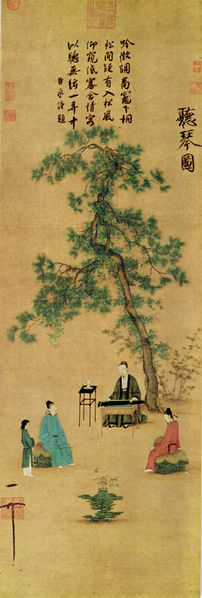 Musical forms considered superstitious or anti-revolutionary were repressed, and harmonies and bass lines were added to traditional songs. One example is The East Is Red, a folksong from northern Shaanxi which was adapted into a nationalist hymn. Of particular note is the composer, Xian Xinghai, who was active during this period, and composed the Yellow River Cantata which is the most well-known of all of his works.
Musical forms considered superstitious or anti-revolutionary were repressed, and harmonies and bass lines were added to traditional songs. One example is The East Is Red, a folksong from northern Shaanxi which was adapted into a nationalist hymn. Of particular note is the composer, Xian Xinghai, who was active during this period, and composed the Yellow River Cantata which is the most well-known of all of his works.
People's Republic of China era (1949 - 1990s)
The golden age of shidaiqu and the Seven great singing stars would come to an end when the Communist party denounce Chinese popular music as yellow music (pornography).[2] Maoists considered pop music as a decline to the art form in the mainland. In 1949 the Kuomintang relocated to Taiwan, and the People's Republic of China was established. Revolutionary songs would become heavily promoted by the state. The Cultural Revolution and other Maoist made revolutionary songs an acceptable genre to the point where it overshadowed other genre and almost define what mainland music is.
After the Tiananmen Square protests of 1989, a new fast tempo Northwest Wind (xibeifeng, 西北風) style was launched by the people to counter the government. The music would progress into Chinese rock, which remained popular in the 1990s. However, music in China is very much state-owned as the TV, media, and major concert halls are all controlled by the Communist party. The government mainly chose not to support Chinese rock by limiting its exposure and airtime. As a result, the genre never reached the mainstream in its entirety.
Current
China has a high piracy rate along with issues of intellectual properties.[3] As a result, most albums are released in Taiwan or Hong Kong first. It is often one of the business decisions made by record companies. Normally there is some delay before the products are released into the mainland, with occasional exceptions, such as the work of Cui Jian who was released in Taiwan, Hong Kong and the mainland simultaneously.[4] Consequently, a delay in release time is also the biggest driver of piracy, since individuals would rather pirate from the outside. Modern market is not only hindered by rights issues, as there are many other factors such as profit margin, income and other economical questions.
Annual events such as the Midi Modern Music Festival in Beijing do keep music culture alive. There was also the "Snow Mountain Music Festival" in Yunnan province 2002. The term "Chinese Woodstock" has been thrown around by Western media for these two events. Both draw sizable crowds outdoor, but the term is not quite official. The Chinese rock movement differed from its Western counterpart in that it never fully made it into mainstream culture due to restrictions by the state.
Today, rock music is centered on almost exclusively in Beijing and Shanghai, and has very limited influence over Chinese society. Wuhan and Sichuan are sometimes considered pockets of rock music culture as well. It points to a significant cultural, political and social difference that exist between China, the West, or even different parts within China. While rock has existed in China for decades, the milestone that put the genre on the international map is when Cui Jian played with The Rolling Stones in 2003, at the age of 42.
Modern music
These are genres that started after 1912 to coincide with the New China.
Pop music
-
Main articles: c-pop and mandopop
C-pop originally began with the shidaiqu genre founded by Li Jinhui in the mainland, with Western jazz influences from the likes of Buck Clayton. After the Communist Party establishment, the Baak Doi record company ended up leaving Shanghai in 1952.[5]
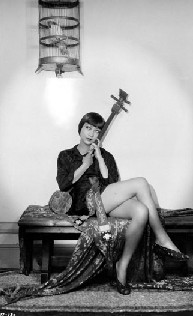 The 1970s saw the rise of cantopop in Hong Kong, and later mandopop in Taiwan. The mainland remained on the sideline for decades with minimal degree of participation. Only in recent years did the youth in mainland resume as a consumer for the Taiwan mandopop market. Still, China is not yet considered a major production hub despite having the largest population[6]. The mainland censorship is strict on popular music even today. When Hong Kong's icon Anita Mui performed the song "Bad Girl" during the 1990s in China, she was banned from returning to the concert for showing a rebellious attitude.[7] By Western standards, the performance was no more rebellious than say, Madonna for example; since Mui based a lot of her dance moves on Madonna's style. Many mainland artists often try to start their commercial success in Hong Kong or Taiwan first, and then re-import into the mainland as part of the gangtai culture.
The 1970s saw the rise of cantopop in Hong Kong, and later mandopop in Taiwan. The mainland remained on the sideline for decades with minimal degree of participation. Only in recent years did the youth in mainland resume as a consumer for the Taiwan mandopop market. Still, China is not yet considered a major production hub despite having the largest population[6]. The mainland censorship is strict on popular music even today. When Hong Kong's icon Anita Mui performed the song "Bad Girl" during the 1990s in China, she was banned from returning to the concert for showing a rebellious attitude.[7] By Western standards, the performance was no more rebellious than say, Madonna for example; since Mui based a lot of her dance moves on Madonna's style. Many mainland artists often try to start their commercial success in Hong Kong or Taiwan first, and then re-import into the mainland as part of the gangtai culture.
Hip hop & rap, rock & heavy metal
- Main articles: Chinese rap, Hong Kong hip hop, Taiwanese hip hop,
Chinese rock
The widely-acknowledged forefather of Chinese rock is Cui Jian.[4] In the late 1980s he played the first Chinese rock song called: "I Have Nothing" ("Yi wu suo you"). It was the first time an electric guitar was used in China. He became the most famous performer of the time, and by 1988 he performed at a concert broadcasted worldwide in conjunction with the Seoul Summer Olympic Games.[4] His socially critical lyrics earned him the anger of the government and many of his concerts were banned or cancelled. After the Tiananmen Square protests of 1989, he played with a red blindfold around his head as an action against the government.
Following, two bands became famous: Hei Bao (Black Panther) and Tang Dynasty. Both started during the late 1980s and early 1990s. Hei Bao is an old-school rock band whose first CD, Hei Bao used the popular English song ("Don't Break My Heart"). Tang Dynasty was the first Chinese heavy metal band. Its first CD "A Dream Return to Tang Dynasty" combines elements of traditional Chinese opera and old school heavy metal. The album was a major breakthrough releasing around 1991/1992. Unfortunately, one member of Tang Dynasty died shortly after the release.
Around 1994-96: the first thrash metal band, Chao Zai (Overload), was formed. They released three CDs, the last one in cooperation with pop singer Gao Chi of the split-up band The Breathing.
Punk rock
Punk rock became famous in China around 1994 - 1996. The first Chinese artist of the genre was He Yong of nu metal style, influenced by Limp Bizkit, Linkin Park and others.
Around 1995 the first wave of Chinese punk bands appeared in Beijing, and the second generation followed around 1997.
 Many were inspired by Western bands such as Korn, Limp Bizkit or Linkin Park.
China would have their own with Yaksa, Twisted Machine, AK-47, Overheal Tank.
Many were inspired by Western bands such as Korn, Limp Bizkit or Linkin Park.
China would have their own with Yaksa, Twisted Machine, AK-47, Overheal Tank.
National music
Patriotic / Revolutionary
-
Guoyue are basically music performed on some grand presentation to encourage national pride. Since 1949, it has been by far the most government-promoted genre. Compared to other forms of music, symphonic national music flourished throughout the country. In 1969 the cantata was adapted to a piano concerto. The Yellow River Piano Concerto was performed by the pianist Yin Chengzong, and is still performed today on global stages. During the height of the Cultural Revolution, musical composition and performance were greatly restricted. A form of soft, harmonic, generic, pan-Chinese music called guoyue was artificially created to be performed at conservatories. After the Cultural Revolution, musical institutions were reinstated and musical composition and performance revived. At the height of the Mao Zedong era, the music accelerated at the political level into "Revolutionary Music" leaning toward cult status and becoming mainstream under pro-Communist ideology.
Traditional music
Instrumental
-
Traditional music in China is played on solo instruments or in small ensembles of plucked and bowed stringed instruments, flutes, and various cymbals, gongs, and drums. The scale has five notes. Bamboo pipes and qin are among the oldest known musical instruments from China; instruments are traditionally divided into categories based on their material of composition: skin, gourd, bamboo, wood, silk, earth/clay, metal and stone. Chinese orchestras traditionally consist of bowed strings, woodwinds, plucked strings and percussion.
- Instruments
-
- dizi, sheng, paigu, gong, paixiao, guan, bells, cymbals
- erhu, zhonghu, dahu, banhu, jinghu, gaohu, gehu, yehu, cizhonghu, diyingehu, leiqin
- Plucked and struck strings
- guqin,
sanxian, yangqin, guzheng, ruan, konghou, liuqin, pipa, zhu
Chinese vocal music has traditionally been sung in a thin, non-resonant voice or in falsetto and is usually solo rather than choral. All traditional Chinese music is melodic rather than harmonic. Chinese vocal music probably developed from sung poems and verses with music. Instrumental pieces played on an erhu or dizi are popular, and are often available outside of China, but the pipa and zheng music, which are more traditional, are more popular in China itself. The qin is perhaps the most revered instrument in China, even though very few people know what it is or seen and heard one being played. The zheng, a form of zither, is most popular in Henan, Chaozhou, Hakka and Shandong. The pipa, a kind of lute, believed to have been introduced from the Arabian Peninsula area during the 6th century and adopted to suit Chinese tastes, is most popular in Shanghai and surrounding areas.
Ethnic Han music
Han Chinese make up some 92% of the population of China. Ethnic Han music consists of heterophonic music, in which the musicians play versions of a single melodic line. Percussion accompanies most music, dance, and opera.
Chinese Opera
-
Main article: Chinese opera
Chinese opera has been hugely popular for centuries, especially Beijing opera. The music is often guttural with high-pitched vocals, usually accompanied by suona, jinghu, other kinds of string instruments, and percussion. Other types of opera include clapper opera, Pingju, Cantonese opera, puppet opera, Kunqu, Sichuan opera, Qinqiang, ritual masked opera and Huangmei xi.

Folk music
Han folk music thrives at weddings and funerals and usually includes a form of oboe called a suona and percussive ensembles called chuigushou. The music is diverse, sometimes jolly, sometimes sad and often based on Western pop music and TV theme songs. Ensembles consisting of mouth organs (sheng), shawms (suona), flutes (dizi) and percussion instruments (especially yunluo gongs) are popular in northern villages; their music is descended from the imperial temple music of Beijing, Xi'an, Wutai shan and Tianjin. Xi'an drum music consisting of wind and percussive instruments is popular around Xi'an, and has received some popularity outside China in a highly-commercialized form. Another important instrument is the sheng, pipes, which is an ancient instrument that is an ancestor of all Western free reed instruments, such as the accordion. Parades led by Western-type brass bands are common, often competing in volume with a shawm/chuigushou band.
In southern Fujian and Taiwan, Nanyin or Nanguan is a genre of traditional ballads. They are sung by a woman accompanied by a xiao and a pipa and other traditional instruments. The music is generally sorrowful and mourning and typically deals with love-stricken women. Further south, in Shantou, Hakka and Chaozhou, erxian and zheng ensembles are popular.
Sizhu ensembles use flutes and bowed or plucked string instruments to make harmonious and melodious music that has become popular in the West among some listeners. These are popular in Nanjing and Hangzhou, as well as elsewhere along the southern Yangtze area. Sizhu has been secularized in cities but remains spiritual in rural areas.
Jiangnan Sizhu (silk and bamboo music from Jiangnan) is a style of instrumental music, often played by amateur musicians in teahouses in Shanghai, that has become widely known outside of its place of origin.
Guangdong Music or Cantonese Music is instrumental music from Guangzhou and surrounding areas. It is based on Yueju (Cantonese Opera) music, together with new compositions from the 1920s onwards. Many pieces have influences from jazz and Western music, using syncopation and triple time.
Regional music
China has many ethnic groups besides the Han, concentrated in the southeast and northwest. These include Tibetans, Russians, Uyghurs, Manchus, Zhuang, Dai, Naxi, Miao, Wa, Yi, Lisu and Mongolians.
Tibet
-
Main article: Music of Tibet
Tibet is a culturally and ethnically distinct area in southwestern China. Its political status is controversial, with many within Tibet, as well as internationally, supporting independence. One of the major reasons for this sovereignty movement is that the Cultural Revolution decimated aspects of Tibetan culture, although Tibetans were not specifically targeted and was part of the general attack on Chinese culture during the period.
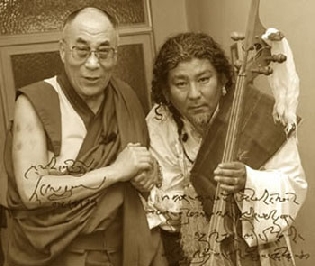 Much of traditional Chinese culture was attacked and rejected during the Cultural Revolution. There are significant minorities of Tibetans in Kham, Bhutan, Nepal and India, as well as in immigrant communities throughout the world.
Much of traditional Chinese culture was attacked and rejected during the Cultural Revolution. There are significant minorities of Tibetans in Kham, Bhutan, Nepal and India, as well as in immigrant communities throughout the world.
Music forms an integral part of Tibetan Buddhism. While chanting remains perhaps the best known form of Tibetan Buddhist music, complex and lively forms are also widespread. Monks use music to recite various sacred texts and to celebrate a variety of festivals during the year. The most specialized form of chanting is called yang, which is without metrical timing and is dominated by resonant drums and sustained, low syllables. Other forms of chanting are unique to Tantra as well as the four main monastic schools: Gelugpa, Kagyupa, Nyingmapa and Sakyapa. Of these schools, Gelugpa is considered a more a restrained, classical form, while Nyingmapa is widely described as romantic and dramatic. Gelugpa is perhaps the most popular.
Secular Tibetan music survived the Cultural Revolution more intact than spiritual music, especially due to the Tibetan Institute of Performing Arts, which was founded by the Dalai Lama shortly after his self-imposed exile. TIPA originally specialized in the operatic lhamo form, which has since been modernized with the addition of Western and other influences. Other secular genres include nangma and toshe, which are often linked and are accompanied by a variety of instruments designed for highly-rhythmic dance music. Nangma karaoke is popular in modern Lhasa. A classical form called gar is very popular, and is distinguished by ornate, elegant and ceremonial music honoring dignitaries or other respected persons.
Tibetan folk music includes a cappella lu songs, which are distinctively high in pitch with glottal vibrations, as well as now rare epic bards who sing the tales of Gesar, Tibet's most popular hero.
Tibetan music has influenced the pioneering compositions of Philip Glass and, most influentially, Henry Eichheim. Later artists made New Age fusions by pioneers Henry Wolff and Nancy Hennings. These two collaborated on Tibetan Bells, perhaps the first fusion of New Age and Tibetan influences, in 1971. Glass' Kundun soundtrack proved influential in the 1990s, while the popularity of Western-adapted Buddhism (exemplified by Richard Gere, Yungchen Lhamo, Steve Tibbetts, Choying Drolma, Lama Karta and Kitaro and Nawang Khechong) helped further popularize Tibetan music.
With the arrival of Tibetan refugees in the Himalayas, Western music, often in unique Tibetan forms, started to become popular among Tibetans everywhere. Rangzen Shonu quickly became the most popular ethnically Tibetan performers of Western rock and pop. Other forms of imported pop music include Indian ghazal and filmi, popular across the Himalayas and in Tibetan communities worldwide. Tibetan-Western fusions have been long suppressed in China itself, but have been widespread and innovative outside of the country. In the mid- to late 1980s, a relaxation of governmental rules allowed a form of Tibetan pop music to emerge in Tibet proper. Direct references to native religion is still forbidden, but commonly-understood metaphors are widespread. Pure Tibetan pop is heavily influenced by light Chinese rock, and includes best-sellers like Jampa Tsering and Yatong. Politically and socially aware songs are rare in this form of pop, but commonplace in a second type of Tibetan pop. Nangma karaoke bars appeared in 1998 and are common in Lhasa, in spite of threats from the Chinese government.
Guangxi
-
Guangxi is a region of China, the Guangxi Zhuang Autonomous Region.
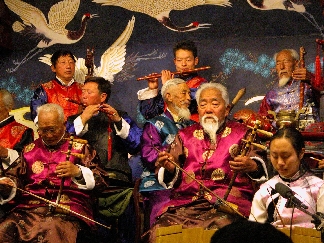 Its most famous modern musician is Sister Liu, who was the subject of a 1960s film that introduced Guangxi's cultures to the rest of the world.
Its most famous modern musician is Sister Liu, who was the subject of a 1960s film that introduced Guangxi's cultures to the rest of the world.
The Gin people are known for their instrument called duxianqin (独弦琴, pinyin: dúxiánqín; lit. "single string zither"), a string instrument with only one string, said to date back to the 8th century.
Yunnan
-
Yunnan is an ethnically diverse area in southeast China. Perhaps best-known from the province is the lusheng, a type of mouth organ, used by the Miao people of Guizhou for pentatonic antiphonal courting songs.
The Hani of Honghe Prefecture are known for a unique kind of choral, micro-tonal rice-transplanting songs.
The Nakhi of Lijiang play a type of song and dance suite called baisha xiyue, which was supposedly brought by Kublai Khan in 1253. Nakhi Dongjing is a type of music related to southern Chinese forms, and is popular today.
|
Notes
- ^ a b Jones. Andrew F. [2001] (2001). Yellow Music - CL: Media Culture and Colonial Modernity in the Chinese Jazz Age. Duke University Press. ISBN 0822326949
- ^ Broughton, Simon. Ellingham, Mark. Trillo, Richard. [2000] (2000) World Music: The Rough Guide. Rough Guides Publishing Company. ISBN 1858286360
- ^ BuildingIPvalue. "BuildingIPvalue." Recent developments in intellectual property. Retrieved on 2007-04-04.
- ^ a b c Gunde, Richard. [2002] (2002) Culture and Customs of China. Greenwood Press. ISBN 0313308764
- ^ Shoesmith, Brian. Rossiter, Ned. [2004] (2004). Refashioning Pop Music in Asia: Cosmopolitan flows, political tempos and aesthetic Industries. Routeledge Publishing. ISBN 0700714014
- ^ Keane, Michael. Donald, Stephanie. Hong, Yin. [2002] (2002). Media in China: Consumption, Content and Crisis. Routledge Publishing. ISBN 0700716149
- ^ Baranovitch, Nimrod. China's New Voices. University of California press. ISBN 0520234502
- ^ Ebrey, Cambridge Illustrated History of China, 148.
See also
|
Sichuan
-
Sichuan is a province in southwest China. Its capital city, Chengdu, is home to the only musical higher education institution in the region, the Sichuan Conservatory of Music. The province has a long history of Sichuan opera.
Manchuria
-
Manchuria is a region in northeast China, inhabited by ethnic groups like the Manchu. The most prominent folk instrument is the octagonal drum, while the youyouzha lullaby is also well-known.
Xinjiang
-
Xinjiang Uyghur Autonomous Region is dominated by Uyghurs, a Turkic people related to others from Central Asia. The Uyghurs' best-known musical form is the On Ikki Muqam, a complex suite of twelve sections related to Uzbek and Tajik forms. These complex symphonies vary wildly between suites in the same muqam, and are built on a seven-note scale. Instruments typically include dap (a drum), dulcimers, fiddles and lutes; performers have some space for personal embellishments, especially in the percussion. The most important performer is Turdi Akhun, who recorded most of the muqams in the 1950s.
Hua'er
Hua'er is a type of song.
Kuaiban
Kuaiban is a type of rhythmic talking and singing which is often performed with percussive instruments such as hand clackers. The center of kuaiban tradition is Shandong province. Kuaiban bears some resemblance to rap and other forms of rhythmic music found in other cultures.
|
References
- Jones, Steven. "The East Is Red... And White"". 2000. In Broughton, Simon and Ellingham, Mark with McConnachie, James and Duane, Orla (Ed.), World Music, Vol. 2: Latin & North America, Caribbean, India, Asia and Pacific, pp 34-43. Rough Guides Ltd, Penguin Books. ISBN 1858286360.
- Lee, Joanna. "Cantopop and Protest Singers". 2000. In Broughton, Simon and Ellingham, Mark with McConnachie, James and Duane, Orla (Ed.), World Music, Vol. 2: Latin & North America, Caribbean, India, Asia and Pacific, pp 49-59. Rough Guides Ltd, Penguin Books. ISBN 1858286360.
- Lee Yuan-Yuan and Shen, Sinyan. Chinese Musical Instruments (Chinese Music Monograph Series). 1999. Chinese Music Society of North America Press. ISBN 1-880464039
- Rees, Helen with Zingrong, Zhang and Wei, Li. "Sounds of the Frontiers". 2000. In Broughton, Simon and Ellingham, Mark with McConnachie, James and Duane, Orla (Ed.), World Music, Vol. 2: Latin & North America, Caribbean, India, Asia and Pacific, pp 44-48. Rough Guides Ltd, Penguin Books. ISBN 1858286360.
- Shen, Sinyan. Chinese Music in the 20th Century (Chinese Music Monograph Series). 2001. Chinese Music Society of North America Press. ISBN 1880464047.
- Trewin, Mark. "Raising the Roof". 2000. In Broughton, Simon and Ellingham, Mark with McConnachie, James and Duane, Orla (Ed.), World Music, Vol. 2: Latin & North America, Caribbean, India, Asia and Pacific, pp 254-261. Rough Guides Ltd, Penguin Books. ISBN 185828636025.
|
Photo Credits:
(1) Olympics logo, (3) Chinese flag,
(5) Mae Wong with sanxian
(unknown);
(2) China map,
(4) Painting: Song Huizong's
'Listening to the Qin',
(6) Chinese musicians at a restaurant in Shanghai,
(7) Re-enactment of a traditional music performance at Hubei Provincial Museum in Wuhan,
(9) Nakhi musicians,
(11) Wikipedia Logo (by Wikipedia);
(8) Loten Namling with
Dalai Lama (from website);
(10) GNU Logo (by GNU Project).
© The Mollis - Editors
of FolkWorld; Published 07/2008
All material published in FolkWorld is © The
Author via FolkWorld. Storage for private use is allowed and welcome. Reviews
and extracts of up to 200 words may be freely quoted and reproduced, if source
and author are acknowledged. For any other reproduction please ask the Editors
for permission. Although any external links from FolkWorld are chosen with greatest care, FolkWorld and its editors do not take any responsibility for the content of the linked external websites.
FolkWorld - Home of European Music

Layout & Idea of FolkWorld © The Mollis - Editors of FolkWorld

 The People's Republic of China (simplified Chinese: 中华人民共和国; traditional Chinese: 中華人民共和國; pinyin: Zhōnghuá Rénmín Gònghéguó listen ), commonly known as China, is the largest country in East Asia and the third or fourth largest country in the world.
With a population of over 1.3 billion it is the most populous country in the world. Beijing is the capital.
The People's Republic of China (simplified Chinese: 中华人民共和国; traditional Chinese: 中華人民共和國; pinyin: Zhōnghuá Rénmín Gònghéguó listen ), commonly known as China, is the largest country in East Asia and the third or fourth largest country in the world.
With a population of over 1.3 billion it is the most populous country in the world. Beijing is the capital.
 Musical forms considered superstitious or anti-revolutionary were repressed, and
Musical forms considered superstitious or anti-revolutionary were repressed, and  The
The  Many were inspired by Western bands such as
Many were inspired by Western bands such as 
 Much of traditional Chinese culture was attacked and rejected during the Cultural Revolution. There are significant minorities of Tibetans in
Much of traditional Chinese culture was attacked and rejected during the Cultural Revolution. There are significant minorities of Tibetans in  Its most famous modern
Its most famous modern 
 From
From 